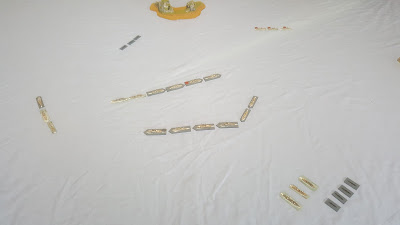So, today is the inaugural International Naval Wargaming Day (INWD), and throughout the day I've been seeing posts, emails and FB messages about games going on across the UK, Europe, North America and Australia (there is even an INWD game happening in Saudi Arabia!). So we seem to have got this event off to a good start. To all naval wargamers observing Fred T Janes' birthday and this international virtual gathering, I salute you!
For my own part I'd hoped to be playing two games but fate intervened and I have only managed the one, but it was a jolly good bash. The battle was based loosely around the Battle of the Yellow Sea, August 10th 1904. In this action a Russian force of battleships under Admiral Vitgeft, with escorting protected cruisers and destroyers, is attempting to escape from Port Arthur and reach the more defensible haven of Vladivostok. In their way is a Japanese force of battleships and armoured cruisers under Admiral Togo, with a squadron of obsolete battleships, protected cruisers and destroyers. The Russians aim is to exit as many of the battleships off the right hand side of the table as they can.
Starting point - Russians to the left (west, Japanese to the right (East)
Vitgeft's Russian squadron
Togo's opposing Japanese fleet
The Japanese battle line, Mikasa in the lead
Vitgeft's heavies - Tsesarevich leading
The fleets close, Japanese light forces to the South, the obsolete battleships closing with Encounter Rock
The fleets turn to the South, Vitgeft's light forces move to the unengaged side
Initially the two battle lines headed on southerly courses to intersect South of Encounter Rock. An early mistake on the part of the commander of the obsolete battleships put them in range of the Russian battle line, the old ships suffering badly. Slowed and separated from Togo's main force, they struggled to escape to the North. The battle lines soon joined,the Japanese heading parallel and south of the Russians aiming to cross their T. Avoiding this, the Russians took a risk in executing a sharp turn to the East, which could have exposed them to concentrated close range Japanese fire, but luck was with them as Togo's battleship was hit hard, suffered an underwater critical hit and this threw the Japanese intended reaction out of kilter. With the Japanese trying to regain control the Russians swept to the East and opened up a lead in the rush to the eastern table edge. Wrong-footed, the Japanese turn came late which meant they spend the rest of the game playing catch-up. A destroyer attack on the head of the Russian line failed to appreciably slow the Russians; a similar attack on the Japanese line also failed, but accurate gunnery concentrated on Togo's flagship caused
Mikasa to drop out of line for more repairs.
The "run to the South" continues - the obsolete BBs find themselves the unwelcome recipients of a flurry of high calibre shells
Ouch! - red markers indicate a ship that has taken damage, black shows a ship that is Silenced (very heavy damage, unable to fire, slowed)
The battle lines come into range, the obsolete Japanese BBs run (crawl?) for safety
Vitgeft makes an unexpected turn to the East, his leading ships take concentrated fore from the Japanese battleships
The Mikasa also takes fire...
...and the next turn is Silenced
Togo's following battleships also take hits (green markers show a ship that is under fire which affects its own gunnery temporarily)
As Togo loses control the Russians sweep past
Togo recovers control, but the Russians are past
The Russian rush for safety brings them back in contact with the obsolete battleships. Meanwhile the Japanese destroyers move in to attack in an attempt to slow the Russian line
A shift of focus as your intrepid war photographer moves to the Eastern side of the table. Destroyer attacks have gone in on the heads of both lines, and both flagships suffer heavy damage
Both admirals concentrate on getting their flagships operational, whilst the training Russian ships trade shots with the Japanese battleships behind them
alas at this point the photographer ran out of film (or more accurately, battery) so this brought the photographic record to an end...
As the Russian battleships headed for safety the leading Japanese battleships now landed a heavy blow to the trailing Russian battleship
Peresviet, which was crippled and stopped. To turn and try to help the crippled battleship would lead to inevitable disaster so the
Peresviet was left to her fate. Vitgeft and his damaged but still seaworthy battleships and cruisers would eventually make the safety of Vladivostok.
So, a Russian victory with some lucky breaks - plus avoiding the death of their Admiral which doomed the Russians in the actual battle and caused them to return to Port Arthur.






































